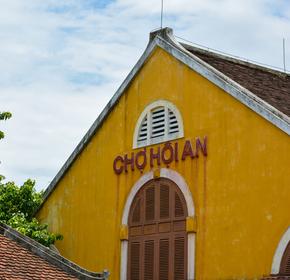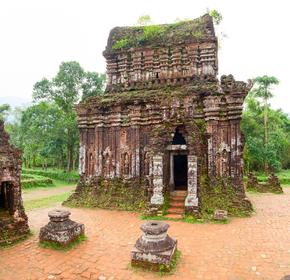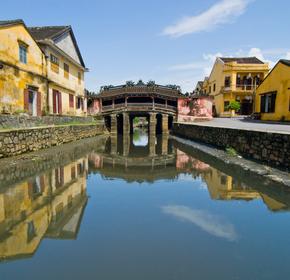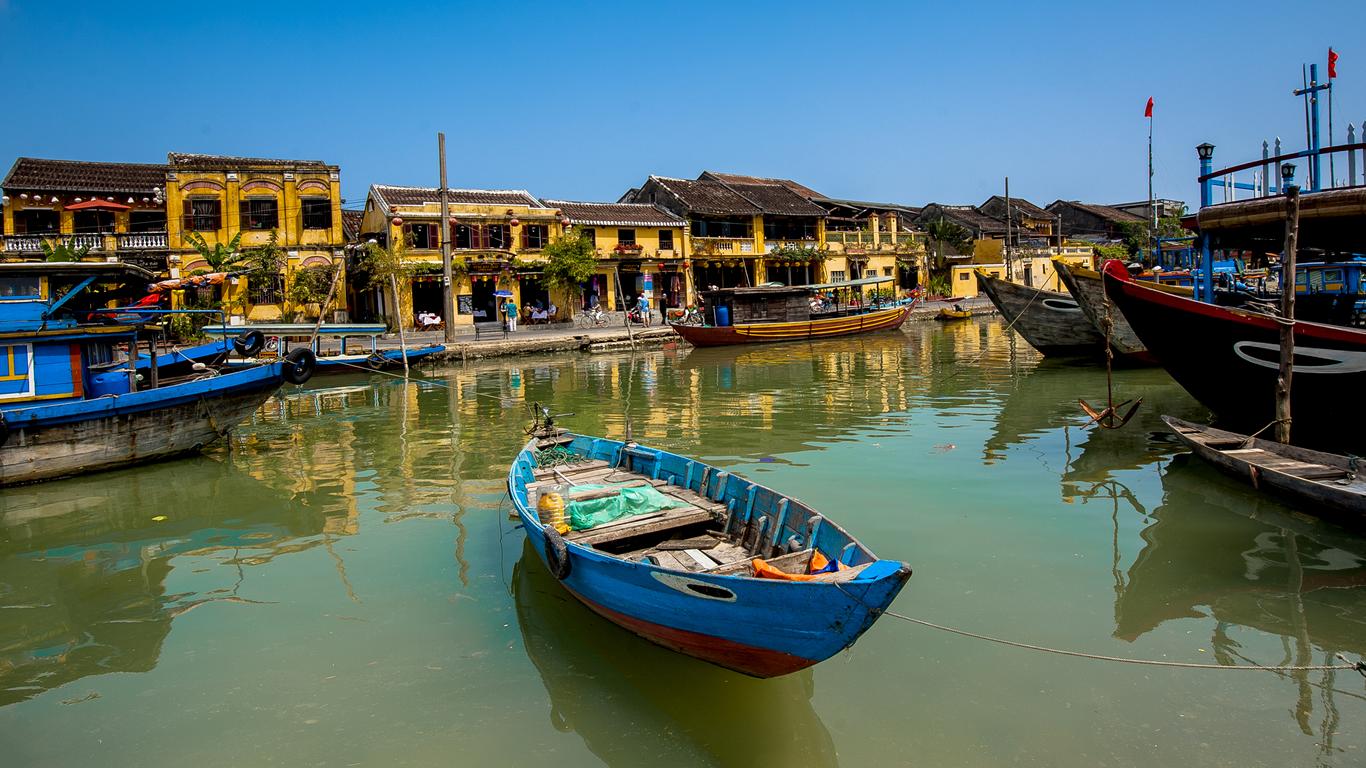
Hoi An travel guide
Hoi An Tourism | Hoi An Guide
You're Going to Love Hoi An
A UNESCO World Heritage Site for good reason, Hoi An marries a storied past to a charming and peaceful aesthetic, while catering to fans of fine clothing from all over the world. The Ancient Town has outstanding examples of Chinese architecture from over a thousand years ago, and there are few concrete buildings to mar the experience.
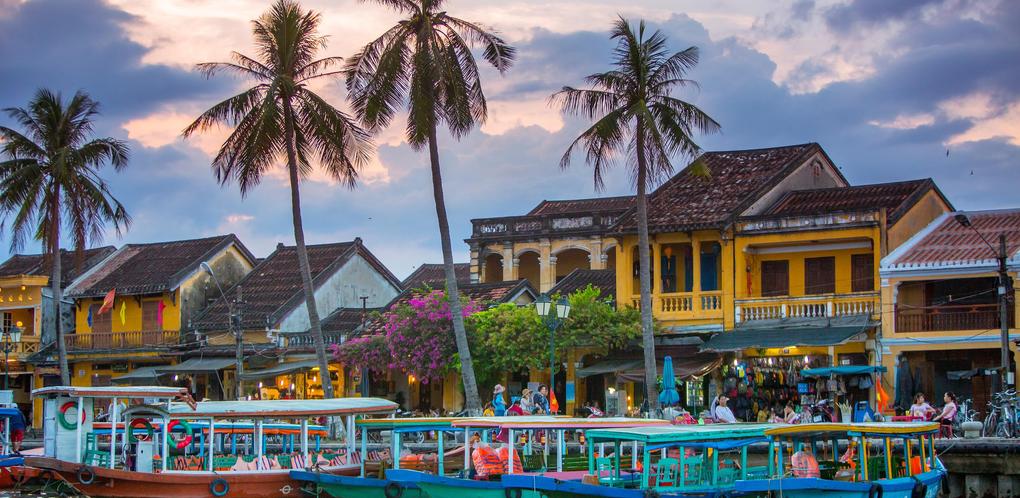
No matter what brings you to the city - its world-renowned garment shops, its amazing cuisine, or its lantern-filled islands - you're sure to be surprised by what you find, and Hoi An caters to both young and old travelers.
Let Hoi An astonish you with its dazzling variety of cultural delights. There is something for everyone in this city.
Top 5 Reasons to Visit Hoi An
1. Serene Atmosphere
Despite Vietnam's rising popularity, Hoi An has maintained a peaceful atmosphere. Even when the town hosts thousands of tourists, its special charm pervades. Unlike other Vietnamese cities, you will find no concrete high rises interspersed with historical buildings here.
2. Fabulous Clothing
Few places in the world offer such great clothing at such low prices. In Hoi An, you can have a tailored suit or dress made within 24 hours. Of course, waiting a few days will improve the quality of your clothing quite a bit, but that's up to you.
3. Intricate Handicrafts
Hoi An's clothing is matched by its leather work, pottery, and painting, which offer tourists countless opportunities to be inspired.
4. Authentic Local Flavors
Hoi An is located about halfway up Vietnam's extensive coastline, so it offers both southern and northern delicacies along with plenty of fresh seafood. Its restaurants have earned the acclaim of both Vietnamese and international foodies.
5. Day Trips to the Mountains
Hoi An is located next to some amazing scenery, including expansive beaches and architectural wonders like the My Son Sanctuary. Jungle and ocean environments are both within striking distance of the city.
What to do in Hoi An
1. Cua Dai Beach: Escape to the Seaside
Mix a little sand into your cultural wanderings when you stop and enjoy the centrally-located Cua Dai Beach. This "hidden beach" in the Northeastern district of Hoi An offers great amenities like beachside bars, restaurants, fire pits, and lounge chairs in a more quiet and private setting. The still waters are also perfect for those traveling with small children or who are looking for a more calming swimming experience. You can also rent bikes for an easier transportation option when exploring around the Cua Dai Beach.
2. Hoi An Ancient Town: Get Lost in the Canals
Who says you need to go to Venice to take advantage of a gondola ride? Here in Hoi An, you can get the same tour ride through the ancient city's many canals for some truly spectacular shopping and eating opportunities. The city's eclectic cultural mix features a hodgepodge of different architectural styles including French colonial buildings, Japanese bridges, Chinese shop houses, and Vietnamese tube-houses. There are also several museums you can visit in the ancient town including the Phuoc Kien Assembly Hall, the Museum of Trade Ceramics, and the Museum of Sa Huynh Culture.
3. Central Market: Try Your Hand at Bartering
Pull up a chair and start your next Vietnamese food adventure at the Central Market. Food stalls line the market's narrow streets in the Minh An neighborhood in front of the Thu Bon River. Prices vary between shops, so it tends to be more affordable if you can gather the courage to barter over the final price. Make an entire day of it as you bounce between stalls, sampling everything from home-style cooked delicacies to exotic raw fruits and vegetables. You'll be happy you took the opportunity to try some truly delicious eats for your next meal in the Central Market.
4. My Son Sanctuary: Get a Glimpse of Ancient Vietnamese Heritage
These derelict Hindu Temples were constructed between the 4th and 14th centuries and contained almost 70 buildings including tombs and in the peak of the site's development. For centuries, religious ceremonies for kings and royalty were carried out within the complex, making it one of the oldest inhabited archaeological sites in the region. Much of the temple complex was destroyed by US attacks during the Vietnam War, leaving just a handful of partially ruined Hindu Temples. The area has been more or less abandoned ever since, offering visitors a glimpse into past Indochina culture and history.
5. Chùa Cầu: Cross the River, Japanese Style
One of the centerpieces of Hoi An Ancient City, the Chua Cau is a popular 18th-century pedestrian wooden bridge made in the Japanese style. Harnessing the art of Zen, the bridge is famous for its elaborate carvings and close access to other Hoi An attractions. Fun fact: according to Japanese legend, the bridge was built to appease an evil monster who plagued India, Japan, and Vietnam from causing earthquakes and other natural disasters in the region.








1. Cua Dai Beach: Escape to the Seaside
Mix a little sand into your cultural wanderings when you stop and enjoy the centrally-located Cua Dai Beach. This "hidden beach" in the Northeastern district of Hoi An offers great amenities like beachside bars, restaurants, fire pits, and lounge chairs in a more quiet and private setting. The still waters are also perfect for those traveling with small children or who are looking for a more calming swimming experience. You can also rent bikes for an easier transportation option when exploring around the Cua Dai Beach.
2. Hoi An Ancient Town: Get Lost in the Canals
Who says you need to go to Venice to take advantage of a gondola ride? Here in Hoi An, you can get the same tour ride through the ancient city's many canals for some truly spectacular shopping and eating opportunities. The city's eclectic cultural mix features a hodgepodge of different architectural styles including French colonial buildings, Japanese bridges, Chinese shop houses, and Vietnamese tube-houses. There are also several museums you can visit in the ancient town including the Phuoc Kien Assembly Hall, the Museum of Trade Ceramics, and the Museum of Sa Huynh Culture.
3. Central Market: Try Your Hand at Bartering
Pull up a chair and start your next Vietnamese food adventure at the Central Market. Food stalls line the market's narrow streets in the Minh An neighborhood in front of the Thu Bon River. Prices vary between shops, so it tends to be more affordable if you can gather the courage to barter over the final price. Make an entire day of it as you bounce between stalls, sampling everything from home-style cooked delicacies to exotic raw fruits and vegetables. You'll be happy you took the opportunity to try some truly delicious eats for your next meal in the Central Market.
4. My Son Sanctuary: Get a Glimpse of Ancient Vietnamese Heritage
These derelict Hindu Temples were constructed between the 4th and 14th centuries and contained almost 70 buildings including tombs and in the peak of the site's development. For centuries, religious ceremonies for kings and royalty were carried out within the complex, making it one of the oldest inhabited archaeological sites in the region. Much of the temple complex was destroyed by US attacks during the Vietnam War, leaving just a handful of partially ruined Hindu Temples. The area has been more or less abandoned ever since, offering visitors a glimpse into past Indochina culture and history.
5. Chùa Cầu: Cross the River, Japanese Style
One of the centerpieces of Hoi An Ancient City, the Chua Cau is a popular 18th-century pedestrian wooden bridge made in the Japanese style. Harnessing the art of Zen, the bridge is famous for its elaborate carvings and close access to other Hoi An attractions. Fun fact: according to Japanese legend, the bridge was built to appease an evil monster who plagued India, Japan, and Vietnam from causing earthquakes and other natural disasters in the region.








Where to Eat in Hoi An
The island of An Hoi is a great option for foodies. Featuring both local and international cuisine, the island's restaurants appeal to a wide range of travelers. Popular eateries on the island include Enjoy Restaurant Ice Cream Bar & Restaurant. Expect prices of about ₫100,000 per meal. Cao lau and White Rose are the local specialties. In addition to the island, the Central Market teems with food stalls, one of which has earned international attention for its Cao Lau and was featured on Anthony Bourdain's travel show.
When to visit Hoi An
The summer months bring crowds and rain to Hoi An. Winter is a much better time to visit. The weather is usually temperate, with temperatures hovering in the 60s in January, and you'll have more luck seeing the city in peace.
How to Get to Hoi An
Plane
Hoi An sits just down the coast from Da Nang Airport (DAD), which serves domestic connections as well as international flights. Once you arrive at the airport, you can take a taxi for approximately ₫500,000 or opt for an airport transfer. Minibus-taxis are also available within the city of Da Nang and cost about ₫40,000 per person.
Train
Those looking to get to Hoi An by train also disembark at Da Nang, which serves many routes to Hanoi, Ho Chi Minh City, Hue, and other locations. Once at the station, a public bus runs to the center of Hoi An every 20 minutes until 6 pm. The cost should be ₫20,000 but you may have to haggle.
Car
International Driver's Licenses are outlawed in Vietnam, so driving is not recommended.
Bus
Hoi An now has two bus stations with buses running to many domestic locations. A public bus runs through Da Nang on a regular basis. Travel companies offer many routes to popular destinations, including Dalat and Nha Trang.
Airlines serving Hoi An
Where to stay in Hoi An
Ancient Town - the Ancient Town is only accessible with a fee, but even the surrounding streets are a blast from the past. Chinese-style houses offer plenty of examples of beautiful architecture; many in the area have been converted into clothing stores.
Popular Neighborhoods in Hoi An
An Hoi - this island is straddled by the Thu Bon River. It features a bustling night market and a beautiful lawn filled with lanterns that often hosts cultural events and festivals.
Cam Nam - a much larger island, Cam Nam is a bit more isolated from the city and boasts a relaxing environment. There are plenty of riverside restaurants to host hungry guests here.
Where to stay in popular areas of Hoi An
Most booked hotels in Hoi An
How to Get Around Hoi An
Public Transportation
Hoi An does not have an extensive bus system, as it is a relatively small city. However, it does have boat taxis. The city's river system is quite large, and locals still travel by boat, much as they did hundreds of years ago.
Taxi
Taxis can be found in Hoi An in Le Loi Street and on An Hoi island. 15 minutes will usually cost travelers around ₫60,000.
Car
As International Driver's Licenses are not recognized in Vietnam, driving cars is not recommended.
The Cost of Living in Hoi An
Shopping Streets
With over 600 clothing stores, nearly the entire city is a shopping district. The old quarter has perhaps the highest concentration of stores, but there are plenty to be found throughout Hoi An.
Groceries and Other
If you're looking to buy groceries, try going to areas of the city that have lower tourist populations. Street vendors sell all sorts of fruit and nuts there. Hoi An does not have major supermarkets, but Ly Thuong Kiet has many smaller grocery stores. Apples cost about ₫40,000 per pound, while bread fetches around ₫13,000 a loaf.
